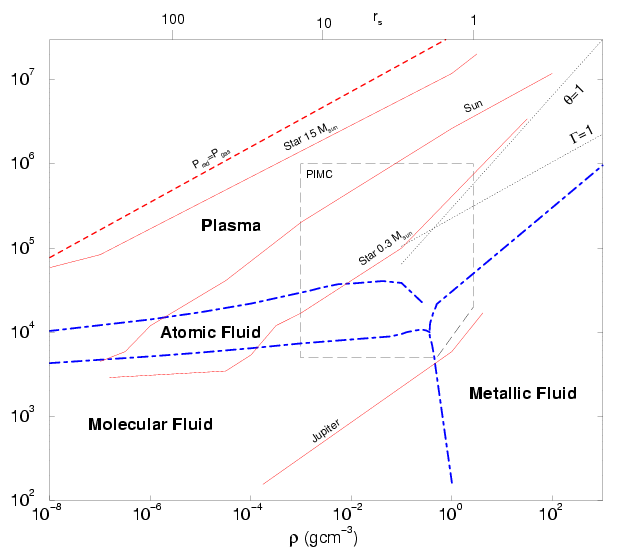
|
Giant planets and brown dwarfs consist of more than 90% hydrogen. The same hydrogen content is found in main sequence stars in the initial phase when they formed by the collapse of hydrogen clouds. Then nuclear reactions reduce the fraction of hydrogen in the process of stellar evolution. The high content of hydrogen is the reason why the high temperature equation of state is relevant for the static properties of these objects and why they enter into models that determine their evolution (Burrows et al., 1997). In these model, one assumes a well mixed state that corresponds to an isentropic change of state from core to surface.

|
In Fig. 1.2, curves from models for the interior of Jupiter and different stars are shown. The gaseous envelope of Jupiter is dominated by molecules. Further inside, pressure and density are sufficiently high that one can expect to find metallic hydrogen. If there existed a PPT, there would be a critical radius, at which the density is discontinuous. The two phases would have different properties such as the solubility of helium. As a consequence, helium would primarily be concentrated in one of the two phases.
The other curves in Fig. 1.2 represent stars
with 0.3, 1, and 15 solar masses (![]() ). The low mass star of
). The low mass star of ![]() exhibits a complex change of properties. Near its core, one
finds a moderately degenerate plasma (
exhibits a complex change of properties. Near its core, one
finds a moderately degenerate plasma (![]() ). With increasing
radius, the temperature decreases, which increases the coupling and
promotes recombination processes. Eventually, all free electrons will
be bound in atoms, which leads to a non-degenerate atomic fluid. Near the
surface, the temperature will be low enough so that molecules can form, which
at some point will become the predominant species.
). With increasing
radius, the temperature decreases, which increases the coupling and
promotes recombination processes. Eventually, all free electrons will
be bound in atoms, which leads to a non-degenerate atomic fluid. Near the
surface, the temperature will be low enough so that molecules can form, which
at some point will become the predominant species.
The sun is hotter and less dense. Near the core, it is weakly coupled
and moderately degenerate. The coupling parameter stays approximately
constant (
![]() ). Near the surface, the temperature is
reduced to about
). Near the surface, the temperature is
reduced to about ![]() , recombination takes place and atoms
are formed.
, recombination takes place and atoms
are formed.
For a more massive star of ![]() , the modeling is simpler
because it remains in a weakly coupled and hardly degenerate
regime. However, the radiation leads to a significant contribution to
the pressure. Brown dwarfs occupy the region between the curves of
Jupiter and the
, the modeling is simpler
because it remains in a weakly coupled and hardly degenerate
regime. However, the radiation leads to a significant contribution to
the pressure. Brown dwarfs occupy the region between the curves of
Jupiter and the ![]() star.
star.